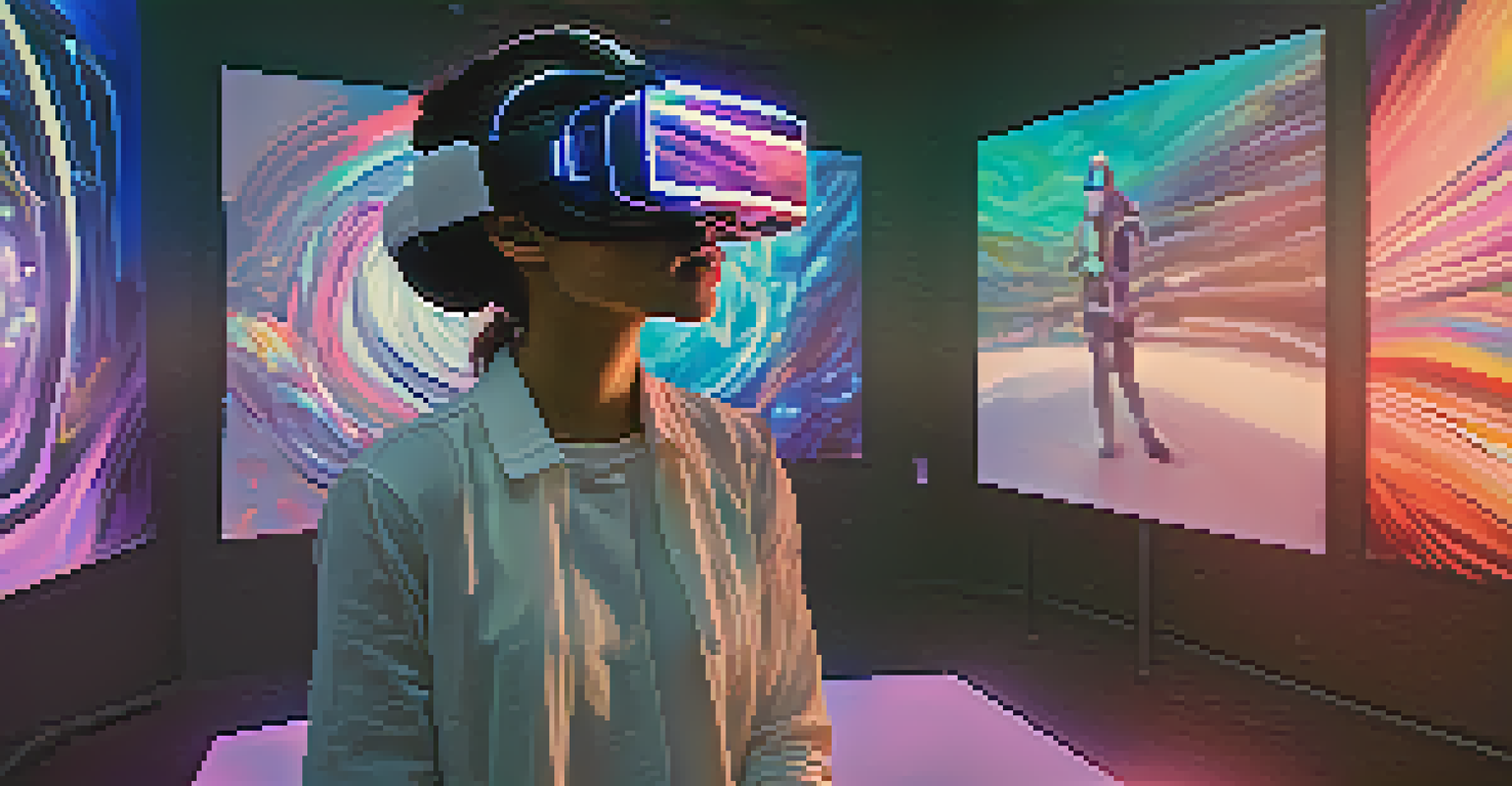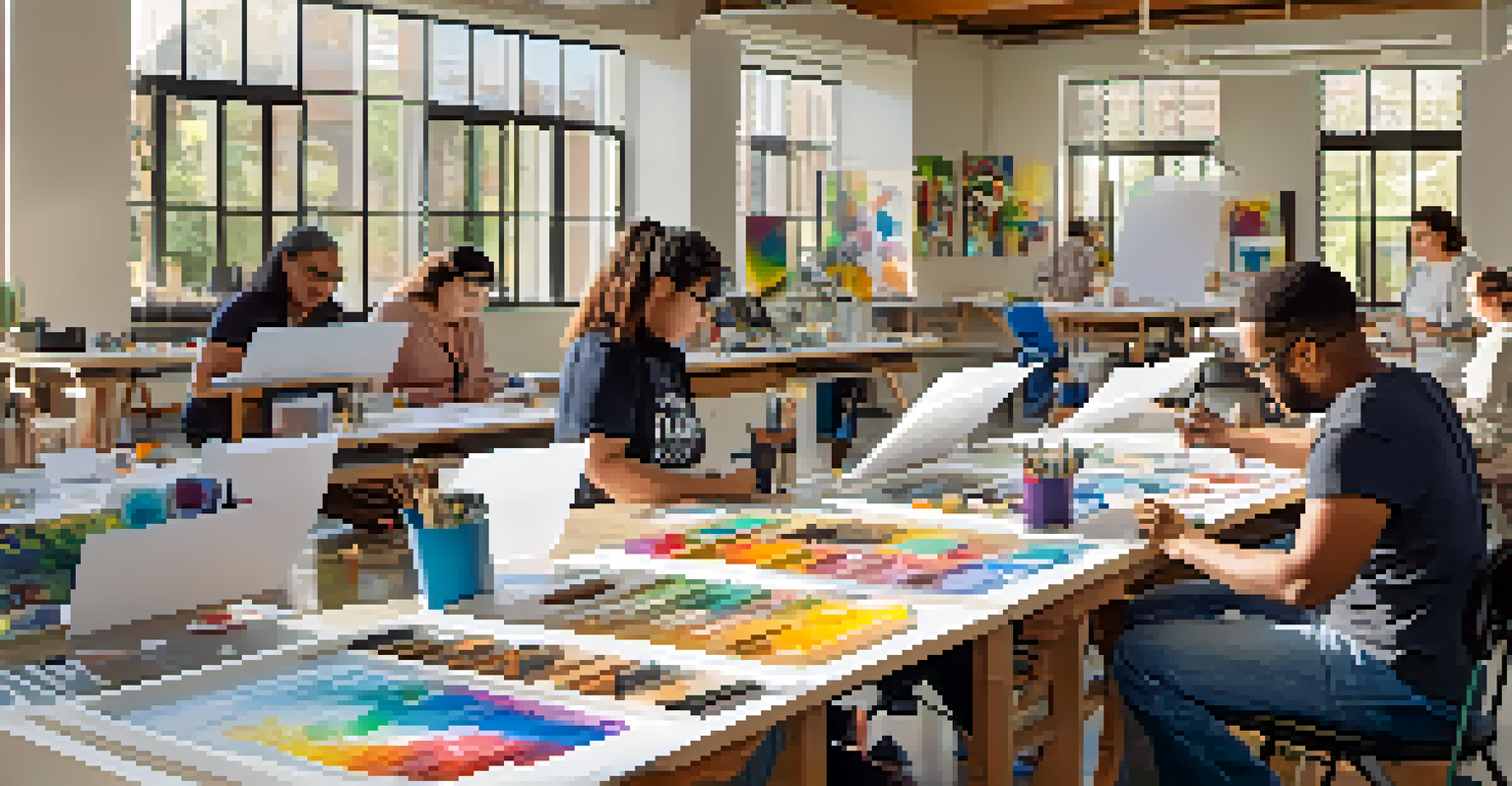The Role of Technology in Democratizing Art Education Today

The Shift Towards Online Art Education Platforms
In recent years, online art education platforms have exploded in popularity, offering courses that cater to a diverse audience. This shift allows students from all backgrounds to access quality instruction without geographical barriers. For instance, platforms like Skillshare and Coursera provide courses taught by experienced artists and educators that can be accessed from anywhere with an internet connection.
Education is the most powerful weapon which you can use to change the world.
This accessibility is particularly beneficial for those who may not have access to local art schools or workshops. Imagine a budding artist living in a rural area now able to learn from renowned instructors halfway across the globe. This democratization of art education ensures that talent is nurtured regardless of location.
Furthermore, the flexibility of online learning enables individuals to learn at their own pace. This is especially important for adult learners who may be balancing other responsibilities. The ability to pause, rewind, and revisit lessons makes the learning process more effective and enjoyable.
The Impact of Social Media on Art Education
Social media platforms like Instagram and TikTok have revolutionized how artists share their work and learn from one another. These platforms not only showcase art but also offer tutorials and behind-the-scenes insights into the creative process. Artists can now connect with peers and mentors globally, fostering a supportive community.

For example, TikTok's short video format allows artists to share quick tips and tricks, making art techniques more digestible for beginners. This peer-to-peer learning creates a dynamic environment where knowledge is shared freely, breaking down traditional barriers that once limited access to art education.
Online Platforms Expand Art Education
Online art education platforms provide accessible, quality instruction to students worldwide, breaking geographical barriers.
Additionally, social media allows for immediate feedback and interaction, which can enhance the learning experience. Artists can post their work, receive constructive criticism, and improve their skills in real-time, making art education a more collaborative and engaging journey.
Virtual Reality and Augmented Reality in Art Learning
Virtual reality (VR) and augmented reality (AR) technologies are pushing the boundaries of art education, making it more immersive than ever. Imagine stepping into a virtual museum or gallery where you can interact with artworks and learn about their history in a captivating way. These technologies can transform how students experience art, offering a multisensory approach to learning.
The beautiful thing about learning is that no one can take it away from you.
For instance, VR can provide art students with simulated environments where they can practice techniques without the constraints of a physical studio. This not only enhances creativity but also allows learners to experiment and take risks in a safe space. As a result, students can build confidence in their skills and express themselves more freely.
Moreover, AR applications can bring art concepts to life, allowing students to visualize complex ideas in an engaging manner. By overlaying digital information onto the real world, learners can gain deeper insights into artistic techniques and styles, making the educational experience more interactive and enjoyable.
Open Educational Resources in Art Education
Open Educational Resources (OER) are reshaping art education by providing free access to quality materials and courses. These resources can include lesson plans, textbooks, and instructional videos, all designed to help students learn without the burden of high costs. This initiative helps to level the playing field for aspiring artists who may not have the financial means to invest in traditional art education.
For example, websites like Open Culture and the Metropolitan Museum of Art offer free art courses and resources that anyone can access. This not only fosters a culture of sharing knowledge but also encourages lifelong learning in the arts, allowing individuals to continuously develop their skills.
Social Media Enhances Learning
Social media platforms foster a supportive community for artists, allowing for peer-to-peer learning and immediate feedback.
By embracing OER, educators can also adapt and modify materials to better fit their teaching styles and students' needs. This flexibility promotes innovation in teaching methods, ensuring that art education remains relevant and engaging in a rapidly changing world.
The Role of Online Communities in Art Education
Online communities have become vital spaces for artists and learners to connect, share ideas, and collaborate. Forums, social media groups, and dedicated art platforms enable individuals to seek advice, share their work, and receive feedback from peers. This sense of belonging can significantly enhance the learning experience and motivate students to pursue their artistic passions.
For example, platforms like DeviantArt and Behance allow artists to showcase their portfolios and connect with others who share similar interests. These communities often host challenges, critiques, and collaborations, creating a vibrant ecosystem where creativity thrives. This support network can be particularly beneficial for emerging artists seeking to build their confidence and skills.
Moreover, online communities provide a safe space for individuals from diverse backgrounds to express themselves and learn from one another. This diversity enriches the learning experience, as students can gain different perspectives and techniques that they may not encounter in traditional classrooms.
Technology's Role in Expanding Art Accessibility
Technology has played a significant role in making art education more accessible to individuals with disabilities. Online resources, adaptive tools, and inclusive teaching methods ensure that everyone, regardless of their physical abilities, can engage with art. This shift towards inclusivity is essential for fostering a diverse artistic community.
For instance, specialized software can assist those with visual impairments in creating digital art, while platforms can offer subtitles and transcripts for online tutorials. By incorporating these technologies, educators can cater to a wider range of learning needs and create an environment where all students can thrive.
Technology Promotes Inclusivity
Advancements in technology, such as adaptive tools and online resources, ensure that art education is accessible to individuals with disabilities.
Additionally, virtual workshops and online exhibitions allow artists with disabilities to showcase their work to a global audience. This visibility not only empowers these artists but also challenges societal perceptions of disability in the art world, promoting a more inclusive narrative.
The Future of Art Education in a Digital Age
As technology continues to evolve, the future of art education looks promising. Emerging technologies like artificial intelligence and machine learning are paving the way for personalized learning experiences tailored to individual needs and preferences. This means that students could receive customized feedback and resources that align with their artistic goals.
Moreover, the integration of gamification in art education can make learning more engaging and enjoyable. By incorporating game-like elements, educators can motivate students to explore new techniques and challenge themselves creatively. This approach can foster a sense of achievement and encourage continuous learning.

Ultimately, the digital age offers unprecedented opportunities for artists and learners alike. By embracing these technological advancements, we can create a more inclusive, diverse, and accessible art education landscape that nurtures creativity for generations to come.